Foodscape: The Diverse Flavors, Sights, and Aromas of Israel
Published May 30, 2023
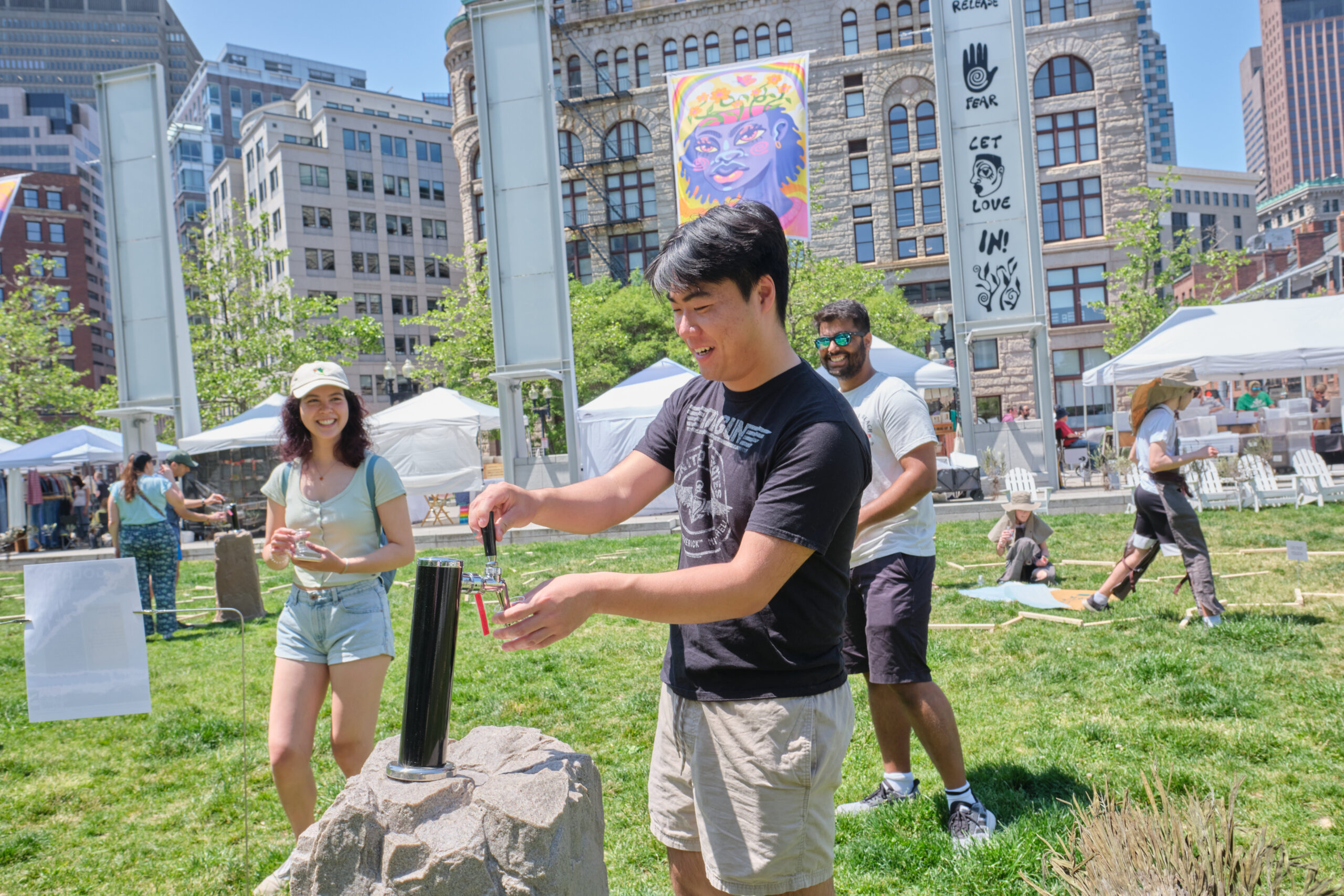
An Immersive Art Experience
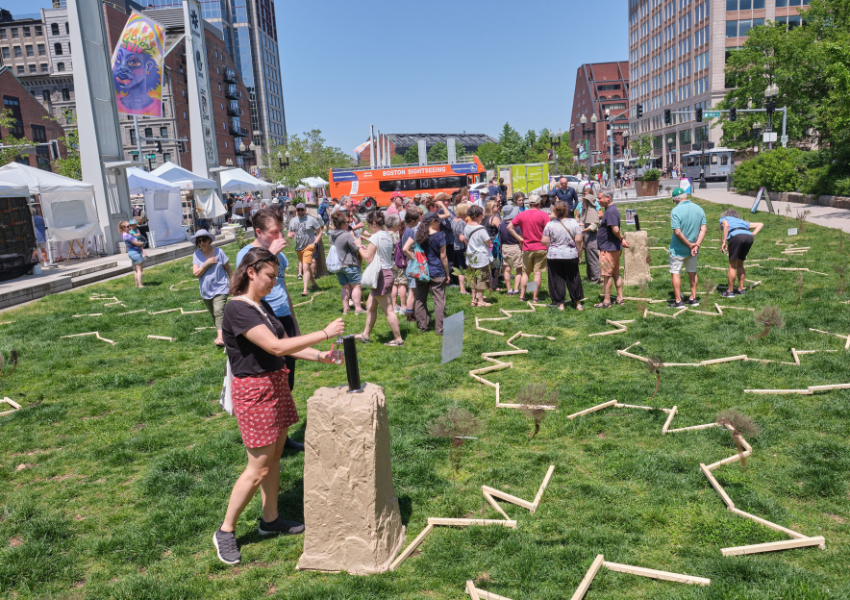
Above: A crowd gathers for an artist-led tour at Foodscape on the Rose Kennedy Greenway in Boston, May 2023. Photo courtesy of George Martell for JArts.
Overview
Foodscape is a 2023 public art exhibit, a unique chance to embark on a journey through the diverse and rich ecosystem of Israel.
Foodscape is the creation of Studio Mela, comprised of artists Carmel Beer and Michal Evyatar, creators of gastronomy-based performance art that connects viewers to history and tradition in multisensory ways.
In Foodscape, Carmel and Michal bring an authentic and visceral taste of the land of Israel to American audiences, featuring plants and herbs that are iconic to the Israeli terroir– a diversity of plants that represent the cultural diversity of the country.
When you step into Foodscape, you are invited to walk through rows of pressed herbs, each selected for its physical and cultural significance. The experience includes a performance by the artists, as they sow and harvest the herbs, and prepare a sweet syrup with the herbs. At different stations throughout the installation, you can taste this syrup in a cool glass of gazoz, a popular carbonated drink in Israel made with the syrup.
Foodscape launched in Boston in May 2023, and tours NY, Baltimore, DC, and Cleveland during summer 2023.
Partners
Foodscape is brought to you by The Jewish Arts Collaborative, BAMAH, and The Consulate General of Israel to New England.
About BAMAH
BAMAH is an independent nonprofit that strengthens connections between communities in North America and Israel by bringing the vibrancy of Israeli culture to U.S. campuses and cities. For more info, please visit BAMAHArts.org.
Miss out on the event in Boston, Baltimore, D.C., or Cleveland? Click through the images above to experience aspects of Foodscape on Kolture. >>>
Seeding the Fields
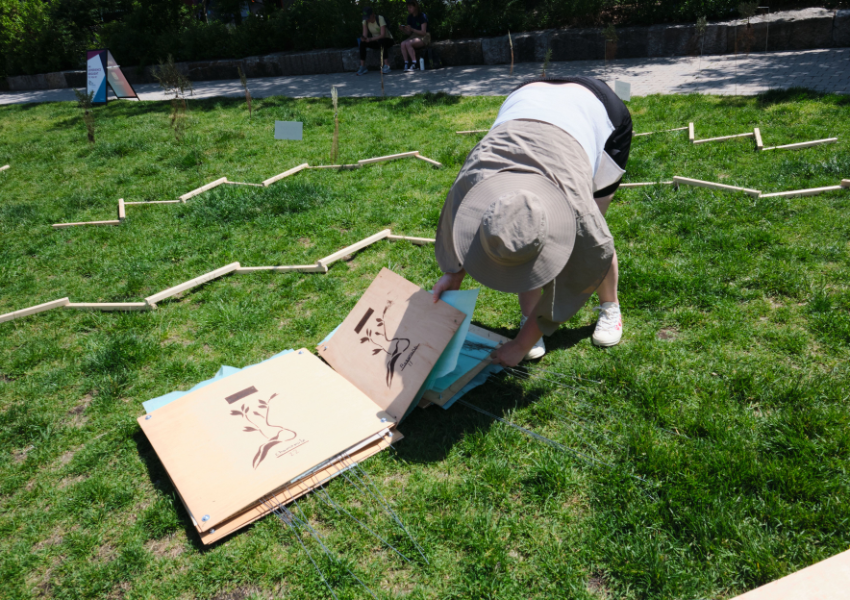
Above: A volunteer removes herbs from the artists’ handmade press to place them on the landscape. Photo courtesy of George Martell for JArts.
GALIL (Audio)
Click PLAY to hear directly from the artists.
PRECIPITATION: 35 IN – 47 IN
ALTITUDE: BETWEEN 1,640 FT – 3,937 FT
WHITE LEAVED SAVORY
זוטה לבנה
عشب
The finest tea herb!
In addition to its medicinal properties, it is incredibly tasty and has a pleasant and exquisite smell.
It seems that all problems can be solved with the White Leaved Savory (and some tea!).
SAVORY OF CRETE
צתרה ורודה
ندغ البساتين
The name of this plant in Hebrew alludes its scientific name (storia) and to the dedication of the plant to the God Saturn. It also originates from the Arabic name, za’atar.
CAROB
חרוב
خروب
Some say that the name Carob comes from the Hebrew word, chorev, a tree that can grow in a dry region.
Others say that the name comes from the word, “to destroy.” Accordingly, it is asked, “Why were they called carobs, which destroy the teeth?”
GOLAN (Audio)
Click PLAY to hear directly from the artists.
PRECIPITATION: 15.7 IN – 63 IN
ALTITUDE: BETWEEN 9,232 FT – 1,300 FT
COMMON FENNEL
שומר פשוט
شومر
Among Israeli Arabs, this plant is used in folk medicine to cure runny noses, hoarseness, indigestion, infections, and a bad taste in the mouth.
LAVENDER
לוונדר
ضرم
The name lavender originates from the Latin verb lavare, which means “to wash,” similar to the way we use lavender today. Because of its clean scent, this herb is an extremely popular ingredient in bathing and cleaning products.
CARMEL (Audio)
Click PLAY to hear directly from the artists.
PRECIPITATION: 35 IN – 47 IN
ALTITUDE: BETWEEN 1,640 FT – 3,937 FT
SAGE
מרווה
ميرميه
There are actually five different names for the Triple Lobed Sage in Arabic: Maryamiyya, Shagera (tree), Fam Alsamaka (fish’s mouth), Jessam, Kusien, Kathir.
ORANGE
תפוז
برتقال
The word orange in Hebrew, Tapuz, is also found hidden in the words, Tapuach Zahav, meaning Golden Apple.
The orange does not grow in the wild.
It was created by hybridization between pomelo and mandarin, carried out by the Chinese during the first millennium AD.
WILD MARJORAM
אזוב מצוי
زعتر
Wild Marjoram is a spice that is a main ingredient in the mixture known as za’atar.
They would often disinfect holy altars with it (as well as anyone infected with leprosy!).
JUDEA (Audio)
Click PLAY to hear directly from the artists.
PRECIPITATION: 15.7 IN – 63 IN
ALTITUDE: BETWEEN 1,312 FT BELOW SEA LEVEL – 3,346 FT
SUMAC
סומק
سماك
Even in the days of the Mishnah, our ancestors used to extract concentrated substances from the sumac tree that were used to process leather, ink, and varnish.
SWEET BAY
ער אציל
غار
The ancient Greeks and Romans attributed magical properties to the Bay Tree and dedicated it to Apollo.
In Ancient Greece, people were decorated with Laurel wreaths for achievements in music, poetry, painting, sculpture, athletics, and horse racing.
ROSE
ורד
و َرد َة
The period of the Roman Empire is characterized by a very wide use of roses for religious purposes, for decoration, and as a symbol of power and status. On special occasions, rose water was even poured through magnificent fountains.
NEGEV (Audio)
Click PLAY to hear directly from the artists.
PRECIPITATION: 9.9 IN – 12 IN
ALTITUDE: BETWEEN 1,210 FT – 1,710 FT
CAROB
חרוב
خروب
Some say that the name Carob comes from the Hebrew word, chorev, a tree that can grow in a dry region.
Others say that the name comes from the word, “to destroy”. Accordingly, it is asked, “Why were they called carobs, which destroy the teeth?”
MARJORAM
מיורן
مردقوش
The main ingredient in the mixture known as za’atar.
It was most often used in ancient times as an antiseptic. They would disinfect holy altars with it (as well as anyone infected with leprosy!).
DATE PALM
תמר מצוי
نخيل
The Date Palm is one of the Holy Land’s most ancient fruit trees and is a symbol of upright stature, justice, and
righteousness.
This symbol has been carved on many coins from the time of the Maccabees (2nd Century BCE) through today.
Speaking with Studio Mela
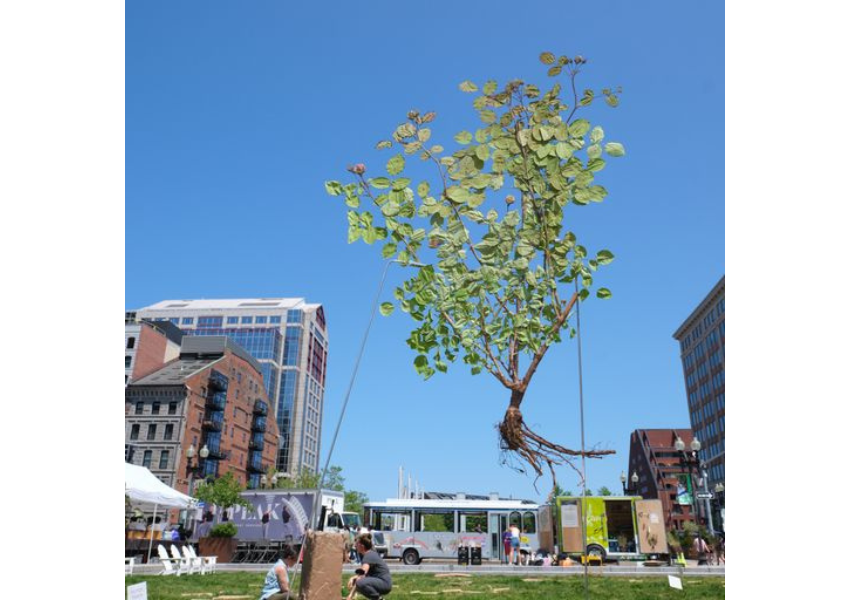
Above: A pressed herb, including its roots, staked into the ground as part of the installation. Photo courtesy of George Martell for JArts.
Where does the concept for Foodscape come from?
In our studio practice, we are constantly seeking to define ourselves and our surroundings through the prism of taste.
The question that often arises is: How can we define a flavor of a certain place?
When thinking of our homeland, Israel, this question becomes complicated. Even Israeli cuisine can be charged with political meaning. We want to avoid this argument and instead consider flavor as a clean, physical, and emotional human experience.
So, we traveled the country, visited various areas in different seasons, and explored the scenery. What we saw was the beautiful flora of Israel. We collected some samples, we tasted them, and we felt at home.
Through Foodscape, we aim to share this experience with audiences outside of Israel by taking them on a multisensory journey through the country’s vegetation and flavors. By extracting, preserving, and infusing the essence of various Israeli herbs into gazoz, participants will be able to experience the tastes of Israel while strolling through a 3,000 square foot representation of its terrain.
While you were building Foodscape, you were also in residence at Washington University and Boston University. How has your Israeli identity informed your teaching experience in the States?
The opportunity of teaching young and enthusiastic students has been a great privilege for us. It allows us to redefine our practice and encounter again and again the importance of the intersection between food, art, and life.
Teaching in the States as an outsider has made us understand even more how food and art define a culture. We’ve had many discussions with our students about the power of food and what we eat to build our bodies and identities.
Our artistic work is very much influenced by our Israeli identity. The attempt to translate this practice to American students was an opportunity to view Israeli culture with new eyes.
What do you hope people will learn or appreciate most about Israel through Foodscape?
We hope that audiences will join us in acknowledging and admiring the diversity of Israeli culture through its flora.
Each plant has its own roots, scents, and medicinal properties. Through these different characteristics, audiences will be able to embark on a profound, sensorial experience, and to let their tongue help orient them in space.
We would also like to emphasize the importance of preservation: Preserving taste, preserving memories, and preserving nature for future generations.
A Taste of the Landscape
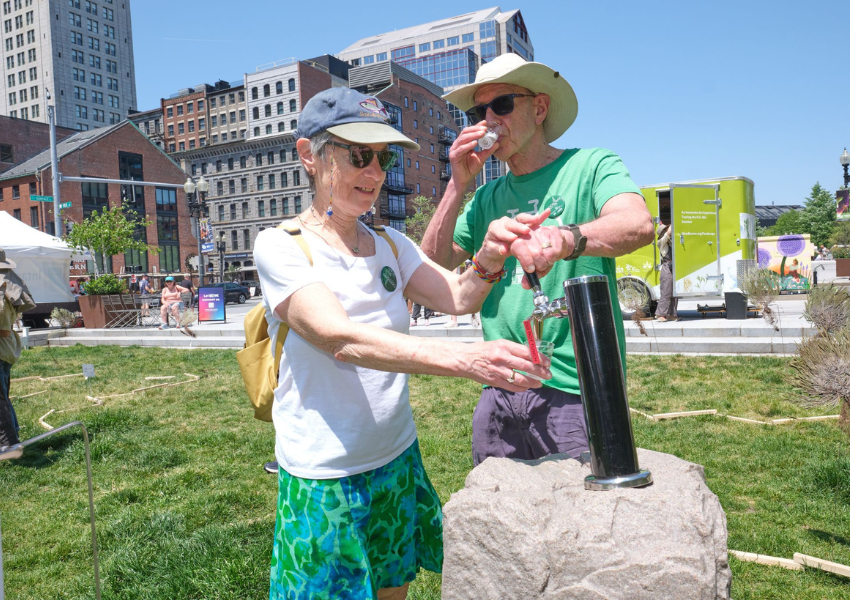
Above: Two participants tasting the herb syrup-infused gazoz in the field. Photo courtesy of George Martell for JArts.
The Process of Making
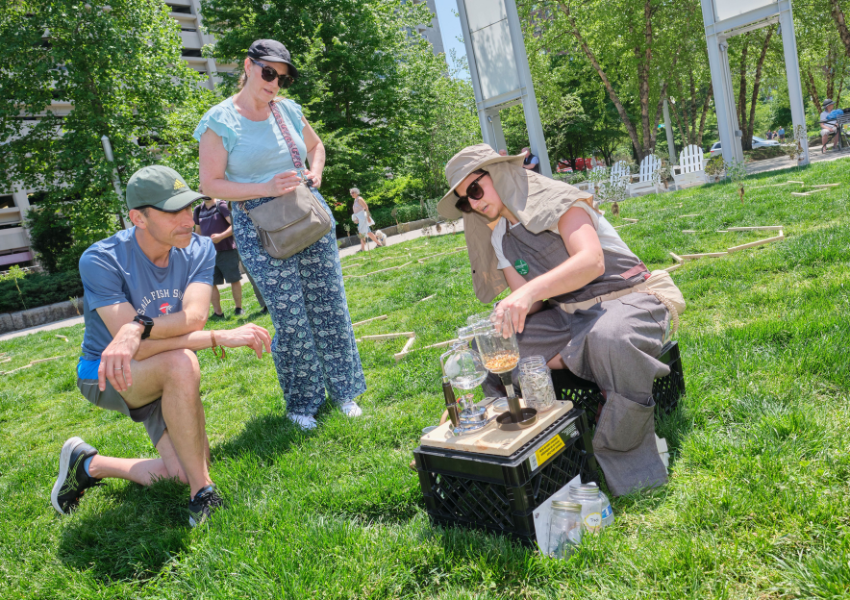
Above: A volunteer explains the process of making the herb syrup to participants as part of the immersive performance aspect of the installation. Photo courtesy of George Martell for JArts.
Walk-through of Foodscape
Above: A walk-through of Foodscape on the Rose Kennedy Greenway in Boston, May 2023. Video courtesy of Talia Boninger for JArts.
Reading Up
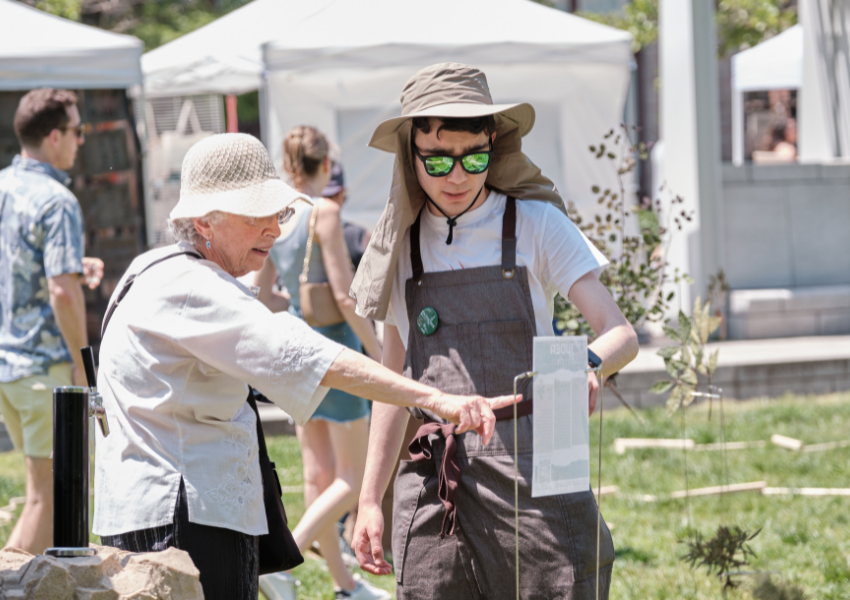
Above: A participant reads information about the herbs in the field with a volunteer nearby. The signs include information about each region and a QR code to the audio tour. Photo courtesy of George Martell for JArts.
JArts’ mission is to curate, celebrate, and build community around the diverse world of Jewish arts, culture, and creative expression. Our vision is of a more connected, engaged, and tolerant world inspired by Jewish arts and culture.
Reflections
The land
“The land of Israel” is cited thousands of times throughout Jewish text. Today, that phrase has become politicized because of how we see Israel in the news. What do you notice or think about Israel when we focus on the physical land?
It's all in the senses
Taste and smell are powerful ways to viscerally evoke memories. Foodscape employs the smells and tastes of Israel to create a connection to the land. Have you been to Israel? What smells or tastes make you think of Israel?
About the size of New Jersey
While physically small, Israel holds many diverse biospheres and terroir, as seen by the many plants in Foodscape. How do you think this diversity impacts the people and culture in the land?
Want more?
Get curated JewishArts.org content in your inbox


